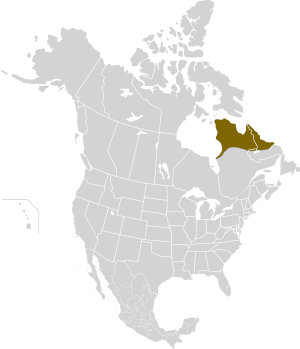Ungava collared lemming facts for kids
Quick facts for kids Ungava collared lemming |
|
|---|---|
| Conservation status | |
| Scientific classification | |
| Genus: |
Dicrostonyx
|
| Species: |
hudsonius
|
 |
|
| Distribution map of the Ungava collared lemming | |
The Ungava collared lemming or Labrador collared lemming (Dicrostonyx hudsonius) is a small animal that lives in North America. It is a type of lemming, which is a small rodent.
Contents
What Does It Look Like?
This lemming has a short, chunky body. Its fur is usually brownish-grey. It has a thin dark stripe along its back and a yellow line on its sides. You might also notice a reddish collar on its chest and a reddish patch behind its ears.
It has small ears, short legs, and a very short tail. When winter comes, its fur turns completely white. It also grows special, larger claws on its front feet. These claws help it dig in the snow and ice.
Ungava collared lemmings are about 14 centimeters (about 5.5 inches) long. Their tail is very short, only about 1.5 centimeters (less than an inch). They weigh around 60 grams (about 2 ounces).
Where Do They Live and What Do They Eat?
These animals live in the cold, open lands called tundra. You can find them in northern Quebec and Labrador in Canada.
In the summer, they eat grasses, sedges, and other green plants. When winter arrives, they switch to eating twigs from trees like willow, aspen, and birch.
Who Are Their Predators?
Many animals hunt the Ungava collared lemming. Some of their main predators include snowy owls, mustelids (like weasels), and Arctic foxes.
Life Cycle and Behavior
How Do They Have Babies?
Female lemmings usually have two or three litters of young each year. Each litter can have four to eight babies. The young lemmings are born in a cozy nest. This nest is often hidden in a burrow underground or tucked away in thick plants.
Daily Life and Homes
Ungava collared lemmings are active all year round, both day and night. They create paths, or "runways," through the plants on the ground. They also dig burrows underground. These burrows are usually above the permafrost, which is ground that stays frozen all the time. In winter, they dig tunnels under the snow to stay safe and warm.
Population Cycles
The number of lemmings in an area changes a lot over time. Their populations go through a cycle of growing very large and then shrinking. This usually happens every three or four years. When there are too many lemmings in one place, they will spread out to find new areas to live.
A Look Back in Time
Scientists have found bones of these lemmings from a long time ago. These remains date back to the end of the last ice age. They were discovered in the Ottawa valley, which is much farther south than where these lemmings live today. This tells us that their habitat has changed over thousands of years.
See also
 In Spanish: Dicrostonyx hudsonius para niños
In Spanish: Dicrostonyx hudsonius para niños


